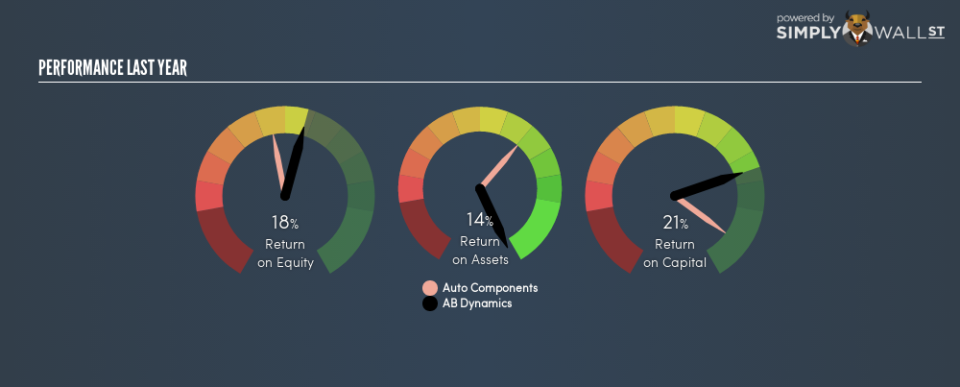Why AB Dynamics Plc’s (LON:ABDP) Return On Capital Employed Is Impressive

Want to participate in a short research study? Help shape the future of investing tools and receive a $60 prize!
Today we’ll evaluate AB Dynamics Plc (LON:ABDP) to determine whether it could have potential as an investment idea. Specifically, we’ll consider its Return On Capital Employed (ROCE), since that will give us an insight into how efficiently the business can generate profits from the capital it requires.
First of all, we’ll work out how to calculate ROCE. Next, we’ll compare it to others in its industry. Finally, we’ll look at how its current liabilities affect its ROCE.
Understanding Return On Capital Employed (ROCE)
ROCE is a metric for evaluating how much pre-tax income (in percentage terms) a company earns on the capital invested in its business. All else being equal, a better business will have a higher ROCE. Ultimately, it is a useful but imperfect metric. Author Edwin Whiting says to be careful when comparing the ROCE of different businesses, since ‘No two businesses are exactly alike.’
So, How Do We Calculate ROCE?
Analysts use this formula to calculate return on capital employed:
Return on Capital Employed = Earnings Before Interest and Tax (EBIT) ÷ (Total Assets – Current Liabilities)
Or for AB Dynamics:
0.21 = UK£7.9m ÷ (UK£49m – UK£10m) (Based on the trailing twelve months to August 2018.)
So, AB Dynamics has an ROCE of 21%.
See our latest analysis for AB Dynamics
Does AB Dynamics Have A Good ROCE?
When making comparisons between similar businesses, investors may find ROCE useful. Using our data, we find that AB Dynamics’s ROCE is meaningfully better than the 12% average in the Auto Components industry. We consider this a positive sign, because it suggests it uses capital more efficiently than similar companies. Regardless of the industry comparison, in absolute terms, AB Dynamics’s ROCE currently appears to be excellent.
It is important to remember that ROCE shows past performance, and is not necessarily predictive. ROCE can be deceptive for cyclical businesses, as returns can look incredible in boom times, and terribly low in downturns. This is because ROCE only looks at one year, instead of considering returns across a whole cycle. Since the future is so important for investors, you should check out our free report on analyst forecasts for AB Dynamics.
How AB Dynamics’s Current Liabilities Impact Its ROCE
Current liabilities are short term bills and invoices that need to be paid in 12 months or less. The ROCE equation subtracts current liabilities from capital employed, so a company with a lot of current liabilities appears to have less capital employed, and a higher ROCE than otherwise. To counter this, investors can check if a company has high current liabilities relative to total assets.
AB Dynamics has total liabilities of UK£10m and total assets of UK£49m. Therefore its current liabilities are equivalent to approximately 21% of its total assets. This is quite a low level of current liabilities which would not greatly boost the already high ROCE.
Our Take On AB Dynamics’s ROCE
Low current liabilities and high ROCE is a good combination, making AB Dynamics look quite interesting. But note: AB Dynamics may not be the best stock to buy. So take a peek at this free list of interesting companies with strong recent earnings growth (and a P/E ratio below 20).
If you like to buy stocks alongside management, then you might just love this free list of companies. (Hint: insiders have been buying them).
To help readers see past the short term volatility of the financial market, we aim to bring you a long-term focused research analysis purely driven by fundamental data. Note that our analysis does not factor in the latest price-sensitive company announcements.
The author is an independent contributor and at the time of publication had no position in the stocks mentioned. For errors that warrant correction please contact the editor at editorial-team@simplywallst.com.

 Yahoo Finance
Yahoo Finance 
